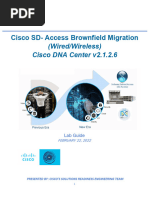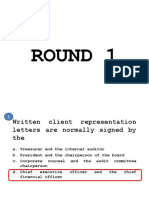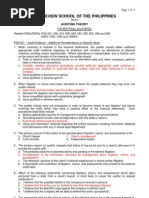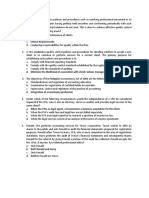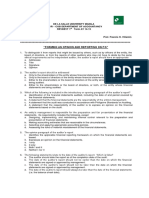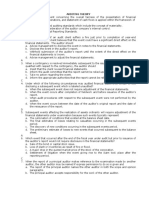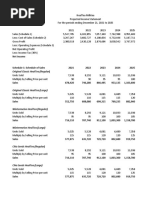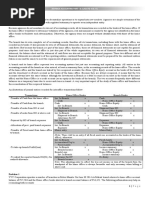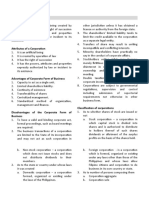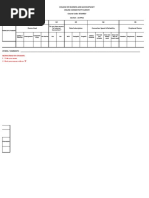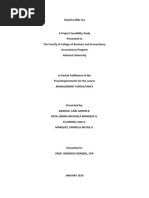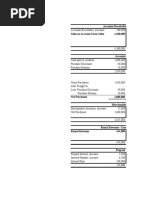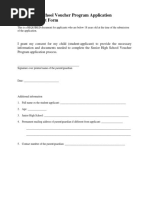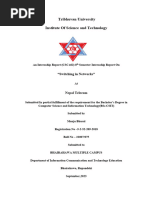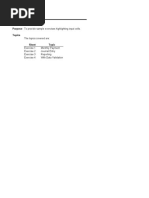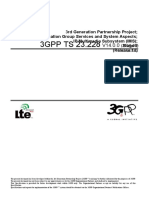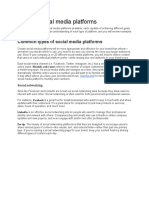Assurance Principles, Professional Ethics and Good Governance
Assurance Principles, Professional Ethics and Good Governance
Uploaded by
Danielle Nicole MarquezCopyright:
Available Formats
Assurance Principles, Professional Ethics and Good Governance
Assurance Principles, Professional Ethics and Good Governance
Uploaded by
Danielle Nicole MarquezOriginal Description:
Original Title
Copyright
Available Formats
Share this document
Did you find this document useful?
Is this content inappropriate?
Copyright:
Available Formats
Assurance Principles, Professional Ethics and Good Governance
Assurance Principles, Professional Ethics and Good Governance
Uploaded by
Danielle Nicole MarquezCopyright:
Available Formats
ASSURANCE PRINCIPLES, PROFESSIONAL ETHICS AND GOOD GOVERNANCE
Adequacy of Presentation and Disclosures
1. Which of the following is a tool that is best used by the audit team to determine completeness disclosures?
a. Representation letter. c. GAAS.
b. Inquiry of the CFO. d. Checklists.
2. Which of the following procedures would an auditor most likely perform in auditing the statement of cash flows?
a. Compare the amounts included in the statement of cash flows to similar amounts in the prior year’s statement of cash
flows.
b. Reconcile the cut-off bank statements to verify the accuracy of the year-end bank balances.
c. Vouch all bank transfers for the last week of the year and first week of the subsequent year.
d. Reconcile the amounts included in the statement of cash flows to the other financial statements’ balances and amounts
Litigation, Claims, Other Contingencies and Commitments
3. The responsibility for designing and maintaining policies and procedures to identify, evaluate, and account for contingencies
rests with whom?
a. Management. c. Audit committee.
b. Auditor. d. Client's attorney.
4. When auditing contingent liabilities, which of the following procedures would be least effective?
a. Reading the minutes of the board of directors.
b. Reviewing the bank confirmation letter.
c. Examining invoices for professional services or analyzing legal expense and review invoices and statements from
outside legal counsel.
d. Examining customer confirmation replies.
5. When requiring a letter of audit inquiry, which is mailed by the auditor after having prepared by the client and reviewed by
the auditor, from the client's attorney, which of the following information will be requested?
a. A statement regarding conflicts of interest that the attorney may have with the client.
b. The attorney's expert opinion of proper GAAP treatment related to client contingencies.
c. An evaluation of the likelihood of unfavorable outcome of, and estimated losses from contingencies.
d. Possible auditor defenses for third-party litigation related to ordinary negligence claims.
6. The appropriate date for the client to specify as the effective date in the audit inquiry to a lawyer is
a. The balance sheet date.
b. Seven working days after the request is received by the lawyer.
c. The date of the audit inquiry itself.
d. The expected date of the completion of audit field work.
Subsequent Events (including subsequent discovery of facts and omitted procedures)
7. The auditor shall perform audit procedures designed to obtain sufficient appropriate audit evidence that all events occurring
between the date of the financial statements and the date of the auditor’s report that require adjustment of, or disclosure
in, the financial statements have been identified. The auditor is not, however, expected to perform additional audit
procedures on all matters to which previously applied audit procedures have provided satisfactory conclusions.
When the auditor identifies events that materially affect the financial statements, the auditor shall determine whether such
events are properly accounted for and adequately disclosed in the financial statements.
a. True, True c. False, True
b. False, False d. True, False
8. Which of the following is least likely a procedure that would be performed by the auditor near the auditor’s report date?
a. Reviewing the procedures that management has established to ensure that subsequent events are identified and
discussing with certain officers the current status of items in the financial statements that were accounted for on the
basis of tentative, preliminary, or inconclusive data.
b. Inquiring of management as to whether any subsequent events have occurred which might affect the financial
statements.
c. Reading the minutes of the meetings of shareholders, the board of directors and audit executive committees held
throughout the audit year.
d. Reading/comparing the entity’s latest available interim financial statements.
9. The auditor has no obligation to perform any audit procedures regarding the financial statements after the date of the
auditor’s report. However, when, after the date of the auditor’s report but before the date the financial statements are
issued, the auditor becomes aware of a fact which may materially affect the financial statements, the auditor shall:
I. Determine whether management will amend the financial statements
II. Discuss the matter with management
III. Determine whether the financial statements need amendment
a. I, II and III c. II, III and I
b. II, I and III d. III, I and II
BAPPEGG – Assurance Principles, Professional Ethics and Good Governance
Completing the Audit Cycle / Auditor’s Report
By: Prof. Davey C. Medidas, CPA, MBA Page 1
10. In relation to No. 9, if management amends the financial statements, the auditor shall:
I. Carry out the audit procedures necessary in the circumstances
II. Review the steps taken by management to ensure that anyone in receipt of the previously issued financial statements
together with the auditor’s report thereon is informed of the situation
III. Issue a new auditor’s report on the amended financial statements
a. I, II and III c. II, III and I
b. I and III d. III, I and II
11. When management does not amend the financial statements in circumstances where the auditor believes they need to be
amended, then (choose the correct statement/s)
I. If the auditor’s report has not yet been issued to the entity, the auditor shall modify the opinion appropriately so that
the auditor expresses a qualified opinion or an adverse opinion.
II. If the auditor’s report has already been issued to the entity, the auditor shall notify management or those charged with
governance, as appropriate, not to issue the financial statements and the auditor’s report thereon to third parties. If
the financial statements are nevertheless subsequently issued, the auditor shall take action, in light of the auditor’s
legal rights and obligations and the recommendations of the auditor’s legal counsel, to prevent reliance on the auditor’s
report.
a. I and II c. II only
b. I only d. Neither I nor II
12. An auditor completed fieldwork on February 10, 2015 for a December 31, 2014 year-end client. A significant subsequent
event occurred on February 22, 2015. In this case, which of the following report dates would not be appropriate?
a. February 10, 2015.
b. February 10, except Note 1, February 22, 2015.
c. February 22, 2015.
d. December 31, 2014.
13. On February 25, a CPA issued an auditor's report expressing an unqualified opinion on financial statements for the year
ended January 31. On March 2, the CPA learned that on February 11, the entity incurred a material loss on an uncollectible
trade receivable as a result of the deteriorating financial condition of the entity's principal customer that led to the
customer's bankruptcy. Management then refused to adjust the financial statements for this subsequent event. The CPA
determined that the information is reliable and that there are creditors currently relying on the financial statements. The
CPA's next course of action most likely would be to
a. Notify the entity's creditors that the financial statements and the related auditor's report should no longer be relied on.
b. Notify each member of the entity's board of directors about management's refusal to adjust the financial statements.
c. Issue revised financial statements and distribute them to each creditor known to be relying on the financial statements.
d. Issue a revised auditor's report and distribute it to each creditor known to be relying on the financial statements.
14. An auditor is considering whether the omission of a substantive procedure considered necessary at the time of an audit
may impair the auditor's present ability to support the previously expressed opinion. The auditor need not apply the
omitted procedure if the
a. Financial statements and auditor's report were not distributed beyond management and the board of directors.
b. Auditor's previously expressed opinion was qualified because of a departure from GAAP.
c. Results of other procedures that were applied tend to compensate for the procedure omitted.
d. Omission is due to unreasonable delays by client personnel in providing data on a timely basis.
15. On March 15, 2015, Kent, CPA, issued an unqualified opinion on a client's audited financial statements for the year ended
December 31, 2014. On May 4, 2015, Kent's internal inspection program disclosed that engagement personnel failed to
observe the client's physical inventory. Omission of this procedure impairs Kent's present ability to support the unqualified
opinion. If the stockholders are currently relying on the opinion, Kent should first
a. Advise management to disclose to the stockholders that Kent's unqualified opinion should not be relied on.
b. Undertake to apply alternative procedures that would provide a satisfactory basis for the unqualified opinion.
c. Reissue the auditor's report and add an explanatory paragraph describing the departure from generally accepted
auditing standards.
d. Compensate for the omitted procedure by performing tests of controls to reduce audit risk to a sufficiently low level.
Going concern
16. When performing risk assessment procedures to obtain an understanding of the entity and to assess the entity’s going
concern, the auditor shall:
I. Inquire of management as to whether events or conditions exist that, individually or collectively, may cast significant
doubt about the going concern assumption
II. Consider management’s assessment of the entity’s ability to continue as a going concern, if such an assessment has
been performed, to determine whether management has identified events or conditions that may cast significant doubt
on the entity’s ability to continue as a going concern and management’s plans to address them
III. Discuss with management the basis for its intended use of the going concern assumption, if management has not yet
performed such an assessment
a. I, II and III c. I and III
b. I and II d. I only
17. Examples of events or conditions which individually or collectively, may cast significant doubt about the going concern
assumption include the following except:
a. Net liability or net current liability position.
b. Change from credit to cash-on-delivery transactions with suppliers.
c. Labor difficulties or shortages of important supplies.
d. Compliance with capital or other statutory requirements.
BAPPEGG – Assurance Principles, Professional Ethics and Good Governance
Completing the Audit Cycle / Auditor’s Report
By: Prof. Davey C. Medidas, CPA, MBA Page 2
18. Which of the following conditions or events most likely would cause an auditor to have substantial doubt about an entity’s
ability to continue as a going concern?
a. Cash flows from operating activities are negative.
b. Research and development projects are postponed.
c. Significant related party transactions are pervasive.
d. Stock dividends replace annual cash dividends.
19. When events or conditions have been identified which may cast significant doubt on the entity’s ability to continue as a
going concern, the auditor shall (choose the incorrect statement)
a. Obtain sufficient appropriate audit evidence to determine whether or not a material uncertainty exists through
performing additional audit procedures, including consideration of other mitigating factors.
b. Evaluate management’s plans for future actions based on its going concern assessment and whether the outcome of
these plans will improve the situation, and obtain sufficient appropriate audit evidence that management’s plans are
feasible in the circumstances.
c. Determine whether any additional facts or information have become available since the date on which management
made its assessment.
d. Not request specific written representations from management regarding its plans for future action.
Concluding (overall or final) analytical procedures
20. Analytical procedures conducted at the end of an audit are performed not only to examine trends and changes, but to ask
"hard questions" about the company's results and its relationship to external factors. Who is the most likely to perform ratio
and trend analysis during the review and finalization stage of the audit the?
a. Junior auditors c. Engagement partner
b. Senior auditor d. Client’s controller
Evaluating the sufficiency and appropriateness of audit evidence
21. After the auditor has completed all audit procedures, it is necessary to combine the information obtained to reach an
overall conclusion as to whether the financial statements are fairly presented. This is a highly subjective process that relies
heavily on:
a. generally accepted auditing standards.
b. the Code of Professional Ethics.
c. generally accepted accounting principles.
d. the auditor’s professional judgment.
Management Representations
22. The objective of the auditor, as required by PSA 580 is to corroborate, by means of written representations
I. The validity of the premises, relating to management’s responsibilities, on which an audit is conducted
II. Other audit evidence obtained with regard to specific assertions in the financial statements
a. I only c. I and II
b. II only d. Neither I nor II
23. When considering the use of management’s written representations as audit evidence about the completeness assertion, an
auditor should understand that such representations
a. Complement, but do not replace, substantive tests designed to support the assertion.
b. Constitute sufficient evidence to support the assertion when considered in combination with a sufficiently low assessed
level of control risk.
c. Are not part of the evidence considered to support the assertion.
d. Replace a low assessed level of control risk as evidence to support the assertion.
24. What is (are) the circumstances the may cause the auditor to doubt the reliability of one or more written representations
I. One or more written representations are inconsistent with other audit evidence
II. The auditor has identified significant issues related to management’s commitment to competence, communication and
enforcement of integrity and ethical values, or diligence.
a. I only c. Either I or II
b. II only d. Neither I nor II
25. When relevant parties do not provide the general or specific written representations requested by the auditor, the auditor
shall
I. Reconsider the assessment of the integrity of management and, where appropriate, those charged with governance
II. Take appropriate actions, including determining the possible effects on the opinion in the auditor’s report
III. Ask for the reasons
a. I, II and III c. III, II and I
b. II, III and I d. III, I and II
26. When relevant parties do not provide the general written representations about the premises, relating to management’s
responsibilities, on which an audit is conducted, the auditor is unable to obtain sufficient appropriate audit evidence. If the
possible effects on the financial statements of such inability are pervasive, the auditor shall disclaim an opinion on the
financial statements. When relevant parties do not provide specific written representations requested by the auditor, it
constitutes a scope limitation. Where this is the case, the auditor shall consider the effect on the opinion in the auditor’s
report in accordance with PSA 705.
a. True, True, c. False, True
b. False, False d. True, False
BAPPEGG – Assurance Principles, Professional Ethics and Good Governance
Completing the Audit Cycle / Auditor’s Report
By: Prof. Davey C. Medidas, CPA, MBA Page 3
27. Which of the following is not likely an element of management representation letter?
a. The letter is addressed to the auditor.
b. The letter would ordinarily be dated the same date as the auditor's report.
c. The letter would ordinarily be signed by the members of management who have primary responsibility for the entity
and its financial aspects, i.e., usually the chief executive officer and the chief financial officer.
d. The letter has opening, scope and opinion paragraphs.
28. An auditor accepted an engagement to audit the 2014 financial statement of RMV Corporation and began fieldwork on
September 30, 2014. RMV gave the auditor the 2014 financial statements on January 7, 2015. The auditor completed the
fieldwork and simultaneously obtains approval of the financial statements by the management on February 10, 2015. The
auditor delivered the report on February 16, 2015. The management representation letter and the auditor’s report should
normally be dated on
a. December 31, 2014
b. January 17, 2015
c. February 10, 2015
d. February 16, 2015
Communication with Various Parties
29. Which of the following is not a required communication with the audit committee?
a. Auditor’s responsibility under GAAP.
b. Analytical review.
c. Audit adjustments.
d. Uncorrected misstatements.
30. Auditors are responsible for determining whether financial statements are materially misstated, so upon discovering a
material misstatement they must bring it to the attention of:
a. Regulators
b. The audit firm’s managing partner.
c. No one in particular
d. The client’s management
Auditor’s Report
31. The auditing profession recognizes the need for uniformity in reporting as a means of
a. Defending against capricious lawsuits c. standardizing the policies of various CPA
b. Upgrading the communication skills of auditors d. Avoiding confusion
32. The most common type of audit report contains
a. The adverse opinion c. The qualified opinion
b. The disclaimer of opinion d. The unqualified opinion
33. The element of the auditor’s report that distinguishes it from reports that might be issued by others is
a. Title c. Auditor’s signature
b. Addressee d. Opinion paragraph
34. The financial statements audited by the auditor are identified in the
a. Opening paragraph c. Opinion paragraph
b. Scope paragraph d. All of the above
35. An auditor has been engaged by the Philippine Bank to audit the ABC Corporations in conjunction with a loan commitment.
The report would most likely be addressed to
a. The shareholders, ABC Corporation c. The board of directors, ABC Corporation
b. The Philippine Bank d. to whom it may concern
36. The auditor may address the report to all of the following, except;
a. The client company c. The President and/or CEO of client company
b. The board of directors of client company d. To whom it may concern
37. The appropriate date for the audit report is the one on which the
a. Client’s fiscal year ended c. Auditor types and delivers the report to client
b. Auditor and the client entered into a contract d. Auditor has concluded procedures in the field
38. An audit report should be dated as of the
a. Date the report is delivered to the entity
b. Date the financial statements were approved by the client management
c. Balance sheet date of the latest period reported on
d. Date a letter of audit inquiry is received from the entity’s attorney of record
39. Both disclaimers and adverse opinions are used
a. Only when the condition is highly materials
b. Whether the condition is material or not
c. Irregardless of client’s choice of a non-GAAP accounting method
d. Irregardless of the auditor’s independence
BAPPEGG – Assurance Principles, Professional Ethics and Good Governance
Completing the Audit Cycle / Auditor’s Report
By: Prof. Davey C. Medidas, CPA, MBA Page 4
40. A statement that the auditor’s responsibility is to express an opinion on the financial statements is contained in the
a. Opening paragraph c. Opening and scope paragraph
b. Scope paragraph d. Opinion paragraph
41. When restrictions that significantly limit the scope of the audit are imposed by the client, the auditor generally should issue
which of the following opinions?
a. Qualified b. Disclaimer c. Adverse d. Unqualified
42. If a publicly held company issues financial statements that purports to present its financial position and results of
operations but omits the statement of cash flows, the auditor ordinarily will express a
a. Unqualified opinion with a separate explanatory paragraph c. Adverse opinion
b. Disclaimer of opinion d. Qualified opinion
43. The auditor would most likely issue a disclaimer of opinion because of
a. Inadequacy of the accounting records
b. Inadequate disclosure of material information
c. A client imposed scope limitation
d. The qualification of an opinion by the auditor of subsidiary where there is a division of responsibility
44. An auditor may not issue a qualified opinion when
a. a scope limitation prevents the auditor from completing an important audit procedure
b. The auditor’s report refers to the work of a specialist
c. An accounting principle at variance with GAAP is used
d. The auditor lacks independence with respect to the audited entity
45. Which of the following statements is correct with respect to explanatory paragraph?
a. They always precede the opinion paragraph
b. They always follow the opinion paragraph
c. Sometimes they precede and sometimes they follow the opinion paragraph
d. They always precede the scope paragraph
46. If comparative financial statements are presented and the present auditor has audited both years, the auditor should
a. Reissue the report c. Redate the report
b. Dual date the report d. Update the report
47. An auditor should disclose the substantive reasons for expressing an adverse opinion in explanatory paragraph
a. Preceding the scope paragraph c. Preceding the opinion paragraph
b. Preceding the opinion paragraph d. Within the notes to the financial statements
48. An auditor should disclose the substantive reasons for expressing qualified opinion in an explanatory paragraph;
a. Preceding the scope paragraph c. Following the opinion paragraph
b. Preceding the opinion paragraph d. Within the notes to the financial statements
49. Which of the following will not result in modification of the auditor’s report?
a. Restrictions imposed by the client
b. Reliance placed on the report of another auditor
c. Inability to obtain sufficient competent evidential matter
d. Inadequacy in the accounting records
50. If the principal auditor decides to refer in the report to the audit made by another auditor
a. The principal auditor assumes responsibility for the report on the other auditor
b. The other auditor is relieved of responsibility for his report but not his work
c. The other auditor is responsible for his report and his work
d. The other auditor is relieved of responsibility for his work but not his report
51. Which of the following modifications of the auditor’s report does not include an additional paragraph?
a. The report is qualified because the financial statements contain a material departure from GAAP.
b. The report includes an emphasis of a matter
c. The audit report indicates a division of responsibility between two CPA firms
d. The report is qualified because the scope of eth auditor’s work was restricted
52. If principal auditors make no reference to other auditors whose work they have relied on as a part of the basis for their
report, the principal auditors
a. Are not required to investigate the professional reputation of the other auditor
b. Are issuing an inappropriate report
c. Are taking full responsibility for the work of the other auditors
d. Are issuing a qualified opinion
53. When financial statements contain a departure from GAAP because, due to unusual circumstances, the statements would
otherwise be misleading, the auditor should explain the unusual circumstances in a separate paragraph and express an
opinion that is
a. Unqualified c. Adverse
b. Qualified d. Qualified or adverse, depending on materiality
BAPPEGG – Assurance Principles, Professional Ethics and Good Governance
Completing the Audit Cycle / Auditor’s Report
By: Prof. Davey C. Medidas, CPA, MBA Page 5
54. An auditor is unable to determine the amounts associated with illegal acts committed by a client. The auditor would most
likely issue
a. Either a qualified opinion or a disclaimer of opinion
b. An adverse opinion
c. Either a qualified opinion or an adverse opinion
d. A disclaimer of opinion
55. The consistency standard dose not apply to an accounting change that results from a change in
a. Accounting principle
b. Accounting estimate
c. Accounting principle inseparable from a change in accounting estimate
d. The reporting entity
56. A disclaimer is issued whenever the auditor
a. Has been unable to satisfy him/herself that the overall financial statements are presented fairly
b. Believes that the overall financial statements are presented fairly
c. Believes that some material part of the financial statements are not presented fairly
d. Has determined that the financial statements are presented fairly
57. An auditor’s report includes the following statement; “the financial statements do not present fairly the financial position,
results of operations, or cash flows in conformity with generally accepted accounting principles.” This auditor’s report was
most likely issued in connection with financial statements that are
a. Inconsistent c. Misleading
b. Based on prospective financial information d. Affected by a material uncertainty
58. When a scope limitation has precluded the auditor from obtaining sufficient appropriate evidential matter to determine
whether certain client acts are illegal, he would most likely express
a. An unqualified opinion with a separate explanatory paragraph
b. Either a qualified opinion or an adverse opinion
c. Either a disclaimer of opinion or a qualified opinion
d. Either an adverse opinion or a disclaimer of opinion
59. When there has been a change in accounting principles, but the effect of the change on the comparability of the financial
statements is not material, the auditor should
a. Refer to the change in an explanatory paragraph
b. Explicitly concur that the change is preferred
c. Not refer to consistency in the auditor’s report
d. Refer to the change in the opinion paragraph
60. With respect to disclosure, the standard audit report
a. States that disclosure is adequate in the financial statements including the footnotes thereto
b. States that disclosure is sufficiently adequate to make the statements not misleading
c. States that all material items are disclosed in conformity with GAAP
d. Implies that disclosure is adequate in the financial statements including the footnotes thereto
***END***
BAPPEGG – Assurance Principles, Professional Ethics and Good Governance
Completing the Audit Cycle / Auditor’s Report
By: Prof. Davey C. Medidas, CPA, MBA Page 6
You might also like
- MCQ - Intro To AuditDocument13 pagesMCQ - Intro To Auditemc2_mcv75% (28)
- Account StatementDocument1 pageAccount StatementKholisile50% (2)
- Cisco SRE - SDA - BrownfieldMigration - LAB GUIDE - 6.0.Document237 pagesCisco SRE - SDA - BrownfieldMigration - LAB GUIDE - 6.0.Raul EnriqueNo ratings yet
- Statement 05-23-2022Document4 pagesStatement 05-23-2022Lan PhanNo ratings yet
- Your Statement: Smart AccessDocument32 pagesYour Statement: Smart Accesstony barlow100% (1)
- 92 Final PB Aud Sep 2022 With AnswerDocument13 pages92 Final PB Aud Sep 2022 With AnswerAlliah Mae AcostaNo ratings yet
- Chapter 17 - Test BankDocument52 pagesChapter 17 - Test Bankjuan100% (2)
- Pre Midterm AFAR PDFDocument12 pagesPre Midterm AFAR PDFDanielle Nicole Marquez100% (1)
- Pre Midterm AFAR PDFDocument12 pagesPre Midterm AFAR PDFDanielle Nicole Marquez100% (1)
- PSA 700, 705, 706, 710, 720 ExercisesDocument11 pagesPSA 700, 705, 706, 710, 720 ExercisesRalph Francis BirungNo ratings yet
- Post Audit Responsibilities QuizDocument3 pagesPost Audit Responsibilities QuizJeane Mae BooNo ratings yet
- Second Pre-Board Activity in Acctg. 204B Auditing Theory Integration BDocument10 pagesSecond Pre-Board Activity in Acctg. 204B Auditing Theory Integration BDonalyn BannagaoNo ratings yet
- TBCH16Document6 pagesTBCH16Charlene MinaNo ratings yet
- TBCH16Document6 pagesTBCH16jecille magalongNo ratings yet
- Chapter12 BWDocument16 pagesChapter12 BWLiliNo ratings yet
- Completing The Audit MC EssayDocument6 pagesCompleting The Audit MC EssayAnonymous 3FZGDKfCVkNo ratings yet
- 95-Final PB-AUDDocument12 pages95-Final PB-AUDKatherine MagpantayNo ratings yet
- Department of Accountancy: Page - 1Document19 pagesDepartment of Accountancy: Page - 1NoroNo ratings yet
- 96 Final PB AUDDocument12 pages96 Final PB AUDGab GabNo ratings yet
- ReportingDocument8 pagesReportingLorrieNo ratings yet
- Department of Accountancy: Page - 1Document17 pagesDepartment of Accountancy: Page - 1NoroNo ratings yet
- IfDocument6 pagesIfCarlo ParasNo ratings yet
- Quizbowl M7&M8Document54 pagesQuizbowl M7&M8Ann Christine C. ChuaNo ratings yet
- Seatwork Answer KeyDocument6 pagesSeatwork Answer KeyKathreen Aya Exconde100% (1)
- AT Quiz 1Document3 pagesAT Quiz 1KathleenNo ratings yet
- Colegio de Dagupan Arellano Street, Dagupan City School of Business and Accountancy Final Examination Auditing and Assurance PrincipleDocument16 pagesColegio de Dagupan Arellano Street, Dagupan City School of Business and Accountancy Final Examination Auditing and Assurance PrincipleFeelingerang MAYora100% (1)
- Materials Comprehensive AUd TheoryDocument15 pagesMaterials Comprehensive AUd TheoryAnonymous EgTu8E6O100% (1)
- Completion of Audit Quiz AnswerDocument10 pagesCompletion of Audit Quiz AnswerAang GrandeNo ratings yet
- MCQ Comprehensive ActivityDocument13 pagesMCQ Comprehensive ActivityMicaela MarimlaNo ratings yet
- Completion of Audit Quiz ANSWERDocument9 pagesCompletion of Audit Quiz ANSWERJenn DajaoNo ratings yet
- Practice Test 4 - Auditing TheoryDocument47 pagesPractice Test 4 - Auditing TheoryApril Rose Sobrevilla DimpoNo ratings yet
- 18 Completing The AuditDocument7 pages18 Completing The Auditrandomlungs121223No ratings yet
- AUD Final Preboard Examination QuestionnaireDocument16 pagesAUD Final Preboard Examination QuestionnaireJoris YapNo ratings yet
- Aaconapps2 00-C91pb2aDocument21 pagesAaconapps2 00-C91pb2aJane DizonNo ratings yet
- Part 10Document5 pagesPart 10chimchimcoliNo ratings yet
- De Leon - F-Quiz - 6.7.2023GCDocument7 pagesDe Leon - F-Quiz - 6.7.2023GCSir AlexNo ratings yet
- At-5915 - Other PSAs and PAPSsDocument11 pagesAt-5915 - Other PSAs and PAPSsPau Laguerta100% (1)
- Audit Reviewer Sample 2Document13 pagesAudit Reviewer Sample 2ChinNo ratings yet
- Questionnaires Aud Theory FinalDocument18 pagesQuestionnaires Aud Theory FinalRandy PaderesNo ratings yet
- At at 1st Preboard Oct08Document12 pagesAt at 1st Preboard Oct08Czarina CasallaNo ratings yet
- At Quizzer 14 - Reporting IssuesDocument18 pagesAt Quizzer 14 - Reporting IssuesRachel Leachon50% (2)
- Unit Xii Copleting The Audit Audit Reports Other ServicesDocument66 pagesUnit Xii Copleting The Audit Audit Reports Other ServicesDieter LudwigNo ratings yet
- Aud FeDocument11 pagesAud FeMark Domingo MendozaNo ratings yet
- CRC Aud RevDocument13 pagesCRC Aud Revpwcpresident.nfjpia2324No ratings yet
- C12 ReviewerDocument17 pagesC12 Reviewerlender kent alicanteNo ratings yet
- 94-Final PB-AUD - UnlockedDocument13 pages94-Final PB-AUD - UnlockedJessaNo ratings yet
- DocDocument13 pagesDocMequen Chille QuemadoNo ratings yet
- Aaconapps2 00-C92pb2aDocument17 pagesAaconapps2 00-C92pb2aJane DizonNo ratings yet
- Lspu - Audit Final ExamDocument10 pagesLspu - Audit Final ExamJamie Rose AragonesNo ratings yet
- At5906 Audit ReportDocument8 pagesAt5906 Audit ReportImelda leeNo ratings yet
- Aud-90 PWDocument17 pagesAud-90 PWElaine Joyce GarciaNo ratings yet
- CPAR Audit PreweekDocument21 pagesCPAR Audit Preweekstellajero624No ratings yet
- AUDITING THEORY QUESTIONS - RemovalDocument4 pagesAUDITING THEORY QUESTIONS - RemovalGerma CosepNo ratings yet
- Chap 1 - 3 TestbankDocument9 pagesChap 1 - 3 TestbankDiane CabiscuelasNo ratings yet
- Auditing Final Exam Without Key PDFDocument10 pagesAuditing Final Exam Without Key PDFdar •100% (1)
- At 93 PWDocument16 pagesAt 93 PWPrinces Joy De GuzmanNo ratings yet
- Psa Challenge #4Document17 pagesPsa Challenge #4clarencerclacioNo ratings yet
- Auditing Theory FinalsDocument17 pagesAuditing Theory FinalsRheu ReyesNo ratings yet
- Annual Update and Practice Issues for Preparation, Compilation, and Review EngagementsFrom EverandAnnual Update and Practice Issues for Preparation, Compilation, and Review EngagementsNo ratings yet
- Engagement Essentials: Preparation, Compilation, and Review of Financial StatementsFrom EverandEngagement Essentials: Preparation, Compilation, and Review of Financial StatementsNo ratings yet
- Audit Risk Alert: General Accounting and Auditing Developments, 2017/18From EverandAudit Risk Alert: General Accounting and Auditing Developments, 2017/18No ratings yet
- The Art and Science of Auditing: Principles, Practices, and InsightsFrom EverandThe Art and Science of Auditing: Principles, Practices, and InsightsNo ratings yet
- Audit Risk Alert: General Accounting and Auditing Developments 2018/19From EverandAudit Risk Alert: General Accounting and Auditing Developments 2018/19No ratings yet
- Business Law: "Serving Towards Your CPADocument19 pagesBusiness Law: "Serving Towards Your CPADanielle Nicole MarquezNo ratings yet
- Original Classic Healtea (Regular)Document5 pagesOriginal Classic Healtea (Regular)Danielle Nicole MarquezNo ratings yet
- A Feasibility Study For National University: Healtea Milk TeaDocument6 pagesA Feasibility Study For National University: Healtea Milk TeaDanielle Nicole MarquezNo ratings yet
- Home Office IntegDocument8 pagesHome Office IntegDanielle Nicole MarquezNo ratings yet
- Review Notes Corporation - Is An Artificial Being Created byDocument39 pagesReview Notes Corporation - Is An Artificial Being Created byDanielle Nicole MarquezNo ratings yet
- College of Business and Accountancy Online Connectivity Survey Course Code: BTAXREV Section: ACTP02Document2 pagesCollege of Business and Accountancy Online Connectivity Survey Course Code: BTAXREV Section: ACTP02Danielle Nicole MarquezNo ratings yet
- A. B. 2. A. B. 3. A. B. C. D. 4.: Profit Loss Profit LossDocument13 pagesA. B. 2. A. B. 3. A. B. C. D. 4.: Profit Loss Profit LossDanielle Nicole MarquezNo ratings yet
- AudProb Quiz No. 6 2nd Term SY 2019 2020Document2 pagesAudProb Quiz No. 6 2nd Term SY 2019 2020Danielle Nicole MarquezNo ratings yet
- Combined HealTea Milk TeaDocument29 pagesCombined HealTea Milk TeaDanielle Nicole Marquez100% (1)
- Accounts Receivable/ Notes Receivable Sales On Account/Gross Sales 4,260,000Document2 pagesAccounts Receivable/ Notes Receivable Sales On Account/Gross Sales 4,260,000Danielle Nicole MarquezNo ratings yet
- SHS VP - Consent FormDocument1 pageSHS VP - Consent FormDanielle Nicole MarquezNo ratings yet
- Cash and Cash EquivalentDocument22 pagesCash and Cash EquivalentDanielle Nicole MarquezNo ratings yet
- Cash and Cash EquivalentDocument22 pagesCash and Cash EquivalentDanielle Nicole MarquezNo ratings yet
- AfarDocument3 pagesAfarDanielle Nicole MarquezNo ratings yet
- RFBT.O 1601.law On Obligations - WithanswersDocument28 pagesRFBT.O 1601.law On Obligations - WithanswersDanielle Nicole MarquezNo ratings yet
- RFBT.O 1602.law On Contracts WithanswersDocument42 pagesRFBT.O 1602.law On Contracts WithanswersDanielle Nicole Marquez0% (1)
- RedSeer Delivery Delight IndexDocument47 pagesRedSeer Delivery Delight IndexKhushboo Shahani ParikhNo ratings yet
- Palash Agarwal - Years of Exp (Fresher) - Agra PDFDocument3 pagesPalash Agarwal - Years of Exp (Fresher) - Agra PDFPalash AgarwalNo ratings yet
- Intern MNJDocument51 pagesIntern MNJManish ShresthaNo ratings yet
- NACH Procedural Guidelines V3.0 PDFDocument144 pagesNACH Procedural Guidelines V3.0 PDFbinal shahNo ratings yet
- Start Here: Click ConsultingDocument10 pagesStart Here: Click ConsultingNyasha MakoreNo ratings yet
- Advanced OpenStack NetworkingDocument63 pagesAdvanced OpenStack Networkingmohamed abdoNo ratings yet
- What Is IUBDocument17 pagesWhat Is IUBtuyambaze jean claudeNo ratings yet
- 3GPP TS 23.228Document316 pages3GPP TS 23.228abhaya456No ratings yet
- MarQuity Sales & Distribution CompendiumDocument9 pagesMarQuity Sales & Distribution CompendiumGarvitaNo ratings yet
- Wi Fi 7 Mlo White Paper Wf7mlowp0622Document15 pagesWi Fi 7 Mlo White Paper Wf7mlowp0622hdl645No ratings yet
- Full Surrender: Direct Transfer To My Account (Not Applicable For NRE A/c)Document2 pagesFull Surrender: Direct Transfer To My Account (Not Applicable For NRE A/c)L.BISHORJIT MEITEINo ratings yet
- Annual-Report - FY 2018 - 2019Document403 pagesAnnual-Report - FY 2018 - 2019sunilNo ratings yet
- Huawei ICT Competition 2021-2022 Exam Outline - Network TrackDocument6 pagesHuawei ICT Competition 2021-2022 Exam Outline - Network TrackTHMEUR BENRAYANo ratings yet
- Barangay Initial InventoryDocument1 pageBarangay Initial InventoryDilg Concepcion100% (1)
- Fidonet: Technology, Tools, and History: TopologyDocument5 pagesFidonet: Technology, Tools, and History: TopologySebas EscalanteNo ratings yet
- Customer Loyalty CC June 2023Document2 pagesCustomer Loyalty CC June 2023Amir RazaNo ratings yet
- UBI1Document66 pagesUBI1Rudra SinghNo ratings yet
- Visa Approved Dual Chip Cards - January 2022Document23 pagesVisa Approved Dual Chip Cards - January 2022王二刚No ratings yet
- GB 2018 ResumeDocument3 pagesGB 2018 Resumeapi-504170287No ratings yet
- Popular Social Media PlatformsDocument5 pagesPopular Social Media PlatformsAdeel Chughtai100% (1)
- Smart Cards: Project Report ONDocument18 pagesSmart Cards: Project Report ONHarsh Narula100% (1)
- HDFC Bank StatementDocument13 pagesHDFC Bank StatementofficialmosessahotaNo ratings yet
- Premium Paid AcknowledgementDocument1 pagePremium Paid AcknowledgementRakesh Kumar BainsNo ratings yet
- Tantangan SIMRS Dalam Penerapan Rekam Medis Elektronik Berdasarkan Permenkes 24 Tahun 2022: Literature ReviewDocument11 pagesTantangan SIMRS Dalam Penerapan Rekam Medis Elektronik Berdasarkan Permenkes 24 Tahun 2022: Literature ReviewWinda PurbaNo ratings yet
- History of AtmDocument3 pagesHistory of AtmRinku SharmaNo ratings yet
- ET PrimeDocument7 pagesET PrimeAakritiVermaNo ratings yet


